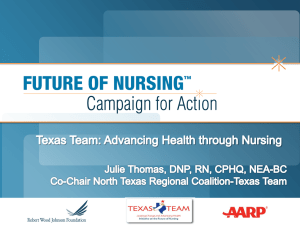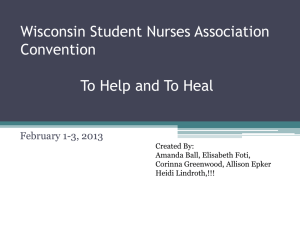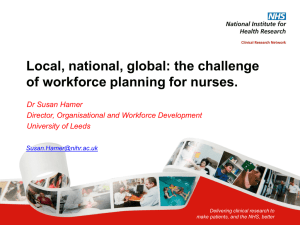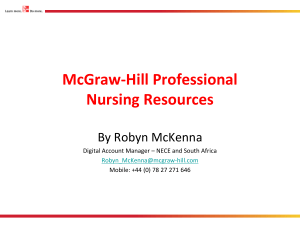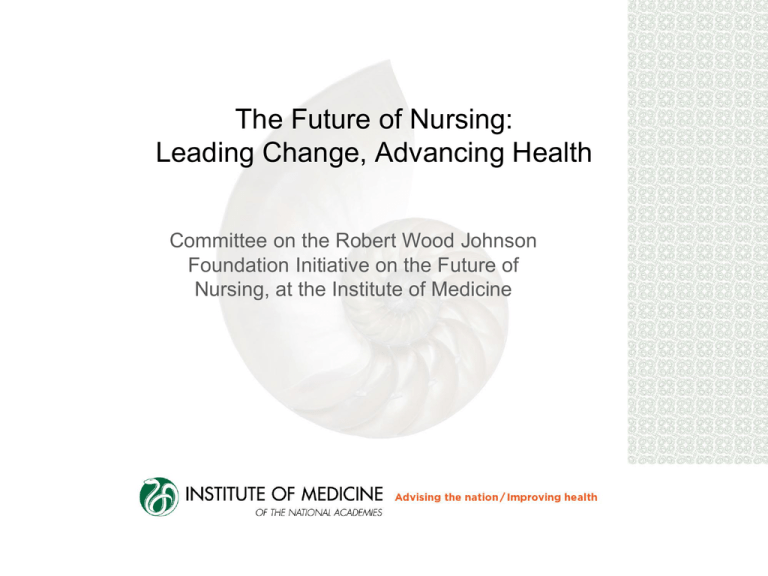
The Future of Nursing:
Leading Change, Advancing Health
Committee on the Robert Wood Johnson
Foundation Initiative on the Future of
Nursing, at the Institute of Medicine
Background and Context
With more than 3 million members, the nursing profession is
the largest segment of the nation’s health care workforce.
Working on the front lines of patient care, nurses can play a
vital role in helping realize the objectives set forth in the 2010
Affordable Care Act.
Legislation enacted will provide insurance coverage to health
care for 32 million more Americans; the implications of this
new demand on the nation’s health care system are
significant.
Background and Context
The Robert Wood Johnson Foundation (RWJF) and
the Institute of Medicine (IOM) partnered to assess
and respond to the need to transform the nursing
profession.
The committee was tasked with producing a report
containing recommendations for an action-oriented
blueprint for the future of nursing, including changes
in public and institutional policies at the national,
state, and local levels.
Committee Task
An ad hoc committee will examine the capacity of the nursing
workforce to meet the demands of a reformed health care
and public health system. It will develop a set of bold
national recommendations, including ones that address the
delivery of nursing services in a shortage environment and
the capacity of the nursing education system.
In its report, the committee will define a clear agenda and
blueprint for action including changes in public and
institutional policies at the national, state and local levels.
Its recommendations would address a range of system
changes, including innovative ways to solve the nursing
shortage in the U.S.
Committee Task (continued)
The committee may examine and produce recommendations related to the
following issues, with the goal of identifying vital roles for nurses in designing
and implementing a more effective and efficient health care system:
Reconceptualizing the role of nurses within the context of the entire
workforce, the shortage, societal issues, and current and future technology;
Expanding nursing faculty, increasing the capacity of nursing schools, and
redesigning nursing education to assure that it can produce an adequate
number of well prepared nurses able to meet current and future health care
demands;
Examining innovative solutions related to care delivery and health
professional education by focusing on nursing and the delivery of nursing
services; and
Attracting and retaining well prepared nurses in multiple care settings,
including acute, ambulatory, primary care, long term care, community and
public health.
Committee on the RWJF Initiative on
the Future of Nursing, at the IOM
18 members with expertise in:
Public health
Nursing
Federal and state administration
Hospital and health plan administration
Business administration
Health information and technology
Health services research
Health policy
Workforce research and policy
Economics
Health care consumer perspective
Study Process
Five committee meetings
Three public workshops
Three public forums (including submission of testimony)
that resulted in published workshop reports
• Acute care
• Care in the community
• Education
Literature review
Five commissioned papers
RWJF Nursing Research Network
Interviews with nurses for case studies and nurse profiles
Committee’s Vision
The committee envisions a future system that makes quality
care accessible to the diverse populations of the United
States, intentionally promotes wellness and disease
prevention, reliably improves health outcomes, and provides
compassionate care across the lifespan. In this envisioned
future, primary care and prevention are central drivers of the
health care system.
Committee’s Vision (continued)
Interprofessional collaboration and coordination are the norm.
Payment for health care services rewards value, not volume of
services, and quality care is provided at a price that is
affordable for both individuals and society. The rate of growth
of health care expenditures slows. In all these areas, the health
care system consistently demonstrates that it is responsive to
individuals’ needs and desires through the delivery of truly
patient-centered care.
Nurses’ Role in This Vision
Nurses are at the front lines in ensuring that care is
delivered safely, effectively, and compassionately.
Because of their regular, close proximity to patients and
their scientific understanding of care processes, nurses
have a considerable opportunity to act as full partners
with other health professionals and to lead in the
improvement and redesign of the health care system and
its practice environment.
Key Messages
1. Nurses should practice to the full extent of their
education and training.
2. Nurses should achieve higher levels of education and
training through an improved education system that
promotes seamless academic progression.
3. Nurses should be full partners, with physicians and other
health care professionals, in redesigning health care in
the United States.
4. Effective workforce planning and policy making require
better data collection and an improved information
infrastructure.
Key Message #1. Nurses should practice to the full extent
of their education and training.
The variability of scope-of-practice regulations across states
may hinder advanced practice nurses from giving care they
were trained to provide and contributing to innovative health
care delivery solutions.
Although some states have regulations that allow nurse
practitioners to see patients and prescribe medications without
a physician’s supervision, a majority of states do not.
The federal government is well suited to promote reform of
states’ scope-of-practice laws by sharing and providing
incentives for the adoption of best practices.
Requirements for physiciannurse collaboration, by state, as a barrier to access to primary
care.
NOTE: Collaboration refers to a mutually agreed upon relationship between nurse and physician.
SOURCE: AARP, 2010b. Courtesy of AARP. All rights reserved.
Key Message #2. Nurses should achieve higher levels
of education and training through an improved
education system that promotes seamless academic
progression.
To ensure the delivery of safe, patient-centered care
across settings, an improved nursing education
system is critical.
To respond to changing patient needs and an
evolving health care systems, nurses must achieve
higher levels of education and training.
Education should include opportunities for seamless
transition into higher degree programs.
Key Message #3. Nurses should be full partners, with
physicians and other health care professionals, in
redesigning health care in the United States.
As leaders, nurses must:
Act as full partners with other health care professionals
Be accountable for their responsibility to deliver high-quality care
Work collaboratively with leaders from other health professions
Identify and propose solutions to problems in care environments
Devise and implement plans for improvement
Participate in health policy decision-making
Key Message #4: Effective workforce planning and
policy making require better data collection and an
improved information infrastructure.
Planning for changes in the education and deployment of the
nursing workforce will require comprehensive data on the numbers
and types of health care providers currently available and required
to meet future needs.
Once an infrastructure for collecting and analyzing workforce data
is in place, systematic assessment and projection of nursing
workforce requirements will be needed to inform necessary
changes in nursing practice and education.
A priority should be placed on systematic monitoring of the supply
of health care workers across profession, review of the data, and
methods needed to develop accurate predictions of future
workforce needs.
Recommendation # 1
Remove Scope of Practice Barriers
Advanced practice registered nurses should be able to practice to the
full extent of their education and training. To achieve this goal, the
committee recommends actions for the following entities:
Congress
State Legislatures
Centers for Medicare and Medicaid Services
Office of Personnel Management
Federal Trade Commission and Antitrust Division of the
Department of Justice
Recommendation # 2
Expand opportunities for nurses to lead and diffuse
collaborative improvement efforts
Private and public funders, health care organizations, nursing
education programs, and nursing associations should expand
opportunities for nurses to lead and manage collaborative efforts with
physicians and other members of the health care team to conduct
research and to redesign and improve practice environments and
health systems. These entities should also provide opportunities for
nurses to diffuse successful practices.
Recommendation # 3
Implement nurse residency programs
State boards of nursing, accrediting bodies, the federal government,
and health care organizations should take actions to support nurses’
completion of a transition-to-practice program (nurse residency)
after they have completed a prelicensure or advanced practice
degree program or when they are transitioning into new clinical
practice areas.
Recommendation # 4
Increase the proportion of nurses with a
baccalaureate degree to 80 percent by 2020
Academic nurse leaders across all schools of nursing should work
together to increase the proportion of nurses with a baccalaureate
degree from 50 to 80 percent by 2020. These leaders should
partner with education accrediting bodies, private and public
funders, and employers to ensure funding, monitor progress, and
increase the diversity of students to create a workforce prepared to
meet the demands of diverse populations across the lifespan.
Recommendation # 5
Double the number of nurses with
a doctorate by 2020
Schools of nursing, with support from private and public
funders, academic administrators and university trustees, and
accrediting bodies, should double the number of nurses with a
doctorate by 2020 to add to the cadre of faculty and nurse
researchers, with attention to increasing diversity.
Recommendation # 6
Ensure that nurses engage in lifelong learning
Accrediting bodies, schools of nursing, health care organizations,
and continuing competency educators from multiple health
professions should collaborate to ensure that nurses and nursing
students and faculty continue their education and engage in
lifelong learning to gain the competencies needed to provide care
for diverse populations across the lifespan.
Recommendation # 7
Prepare and enable nurses to
lead change to advance health
Nurses, nursing education programs, and nursing
associations should prepare the nursing workforce to
assume leadership positions across all levels, while public,
private, and governmental health care decision makers
should ensure that leadership positions are available to and
filled by nurses.
Recommendation # 8
Build an infrastructure for the
collection and analysis of interprofessional
health care workforce data
The National Health Care Workforce Commission, with
oversight from the Government Accountability Office and
the Health Resources and Services Administration, should
lead a collaborative effort to improve research and the
collection and analysis of data on health care workforce
requirements. The Workforce Commission and the Health
Resources and Services Administration should collaborate
with state licensing boards, state nursing workforce centers,
and the Department of Labor in this effort to ensure that the
data are timely and publicly accessible.
Summary
Nurses are committed to delivering high-quality care under
current regulatory, business, and organizational conditions.
The power to change those conditions to deliver better care
does not rest primarily with nurses.
Responsibility also lies with governments, businesses, health
care institutions, professional organizations and other health
professionals, and the insurance industry.
Summary (continued)
The committee’s recommendations are directed to policy
makers; national, state, and local government leaders;
payers; researchers; executives; and professionals,
including nurses; licensing bodies; educational institutions,
and philanthropic and consumer advocacy organizations.
Together, these groups have the power to transform the
health care system to provide seamless, affordable, quality
care that is accessible to all, patient centered, evidence
based and leads to improved health outcomes.





